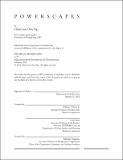Powerscapes
Author(s)
Ng, Chun Lun Otto
DownloadFull printable version (22.00Mb)
Other Contributors
Massachusetts Institute of Technology. Dept. of Architecture.
Advisor
William O'Brien Jr. and Carlo Ratti.
Terms of use
Metadata
Show full item recordAbstract
In 2050, global oil supply will decline to 1/8 of today's. Migrating to the Post-Oil Era, over 10000's km2 of Powerscapes - the solar-collecting infrastructure - will be gradually constructed across the arid desert, for the indispensable production of solar energy to sustain Middle East's economy and global energy supply. The contingency of introducing the Powerscapes is a spatial problem. Unlike a powerplant that burns coal or oil, the scale of the Powerscapes is dramatically extensive. The inserted Powerscapes will interiorize the desert landscape and shelter the ground from the harsh direct sunlight that will be captured for power supply. Transformation in biological development, meteorological activity and geological phenomena will be inevitable, but the change that reduces the heat and evaporation rate will make its climatatic dynamics more habitable for human, animals and plants - an invaluable opportunity for the synthesis of energy production and climate conditioning. This thesis investigates the strategic programming and spatial configuration of such constructed landscape, capitalized by its new temporal characteristics, and sensitively adapting to it. Layers of material will be organized to form "Strata" of temporal conditions to be stretched across the landscape. To forge a symbiotic relationship between Solar Collection, human habitation, agricultural production and wild nature, the layers of material will delineate, push, flip, intersect, puncuate, wrap and merge, responding to programmatic needs and geographical dynamics that the natural geology and the Powerscapes together create. Such adaptive organization also permits certain geometrical and configuration logic to reiterate themselves in multiple scales, formulating a fractalic field with recursive part to whole relationships.
Description
Thesis (M. Arch.)--Massachusetts Institute of Technology, Dept. of Architecture, 2012. This electronic version was submitted by the student author. The certified thesis is available in the Institute Archives and Special Collections. Cataloged from student-submitted PDF version of thesis. Includes bibliographical references (p. 149-151).
Date issued
2012Department
Massachusetts Institute of Technology. Department of ArchitecturePublisher
Massachusetts Institute of Technology
Keywords
Architecture.